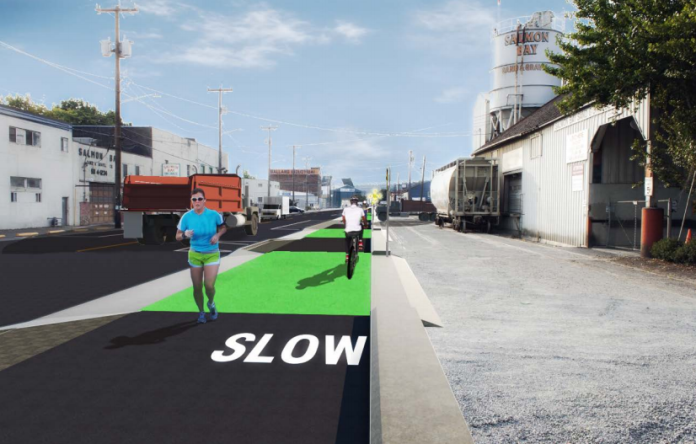The long, winding road of delays and appeals of the Missing Link may be over. On Wednesday, Seattle Deputy Hearing Examiner Ryan Vancil sided with the city on appeal of the Final Environmental Impact Statement (FEIS) to construct new bike facilities in Ballard that would connect two portions of the Burke-Gilman Trail—the Missing Link.
Last summer, the Ballard Coalition filed an appeal on FEIS asserting that the analysis was inadequate. In their testimony to the hearing examiner, the group largely representing industrial and trucking interests made wide ranging charges. They claimed the city attempted to hide potential impacts that sidepath crossings might have on driveways and directed its consultants to shy away from any language in reports that reference impacts. The coalition also contended relying upon a 10% design was insufficient for environmental analysis.
However, the hearing examiner disagreed with these assertions and others in the decision:
- “The analysis of every driveway and truck type that uses those driveways along the Preferred Alternative is not necessary to disclose the impacts associated with driveway crossings and the trail.”
- “The Appellant did not demonstrate that contraflow cycle traffic on a sidepath is so severe a safety risk that additional discussion or analysis was required beyond that already found concerning such potential impacts in the FEIS. The FEIS satisfies the rule of reason with the level of analysis it provides concerning environmental impacts associated with conflicts arising from a sidepath contraflow design.”
- “The City’s methodology for the FEIS’s traffic, safety, and parking impacts analysis was consistent with industry-accepted standards and is legally adequate under the rule of reason. Further, the Appellant did not identify any new significant negative impacts to the environment concerning traffic, safety, or parking, that were not disclosed by the FEIS.”
- “The FEIS is not required to disclose impacts to individuals or individual businesses, but is instead intended to disclose impacts to the environment as a whole. The FEIS is not inadequate where it may have not disclosed impacts to specific businesses. The Appellant did not demonstrate that economic impacts to land uses in the area of the proposal were not addressed by the FEIS.”
While there is still a 21-day appeal period to Superior Court or opportunity to request reconsideration by the hearing examiner, it is not clear that the appellants intend to take the case further. However, it would not be surprising since oppositional groups have been tying up the process to fill in the trail gap for over 20 years and were most recently successful in forcing the city to conduct a full Enivornmental Impact Statement through Superior Court. The burden to appeal the FEIS further, however, is incredibly high now that the hearing examiner has issued this decision.
Under the city proposal, the Burke-Gilman Trail would be filled in between 30th Ave NW to 11th Ave NW along NW Market St, Shilshole Ave NW, and NW 45th St using a variety of trail techniques. In October and November, the city provided updated designs to the 60% and 90% level that included three trail segments:
- NW Market St Segment: the city plans to tighten up the roadway and adjust sidewalk areas so that the south side of the street can accommodate both a 10-foot wide sidewalk and 12-foot wide multi-use path.
- Shilshole Ave NW Segment: the city is considering conversion of on-street parkings on the west side of the street to a 12-foot wide multi-use path.
- NW 45th St Segment: the city plans to construct an in-street bike facility buffered between a travel lane and loading areas.
The latter segment is likely to cause the most heartburn for all parties, but especially bicyclists since the bike facility wouldn’t be elevated above the main roadway despite buffering. Another concern likely to remain is mixing zones throughout the corridor that create conflict points between trail users, pedestrians, and motorists.
Nevertheless, if the project moves forward as largely conceived, construction could begin early this year and wrap up next year.
Stephen is a professional urban planner in Puget Sound with a passion for sustainable, livable, and diverse cities. He is especially interested in how policies, regulations, and programs can promote positive outcomes for communities. With stints in great cities like Bellingham and Cork, Stephen currently lives in Seattle. He primarily covers land use and transportation issues and has been with The Urbanist since 2014.



